A trap with light-emitting diode (LED) lights: Evaluating the effect of location and orientation of lights on the catch rate of snow crab(Chionoecetes opilio)
Khnh Q. Nguyen, Pul D. Winger
a Fisheries and Marine Institute, Memorial University of Newfoundland, 155 Ridge Road, St. John's, NL, A1C 5R3, Canada
b Nha Trang University, 2 Nguyen Dinh Chieu, Nha Trang, 57000, Viet Nam
Keywords:LED Crab trap CPUE Inshore fishery Catchability
A B S T R A C T This study investigated the effect of installing underwater light-emitting diode (LED) lights in different locations(close and distant to the trap entrance) and orientations (normal and upside down direction) inside baited traps targeting snow crab (Chionoecetes opilio) offthe coast of Newfoundland and Labrador, Canada. Four experimental treatments were evaluated in comparison with traditional baited traps (control). Our results showed each of the experimental treatments produced significantly higher (39%-57%; 48% on average) catch per unit effort(CPUE) compared to the control traps, with no significant differences for both legal and sublegal-sized crab among the different experimental treatments. Longer soak times significantly increased the CPUE of the illuminated traps, but did not affect the catch rate of the control traps. Our results also indicated crab size frequency distributions were independent of experiment treatments. Our results suggest that fishing enterprises could improve their catching performance by adding LED lights to their traps, but the location and orientation of the lights appears unimportant.
1. Introduction
Snow crab (Chionoecetes opilio) is a commercially important species on the east coast of Canada, in particular the provinces of Quebec, New Brunswick, Nova Scotia, and Newfoundland and Labrador (Dawe &Mullowney, 2016; DFO, 2016; Hébert, Miron, Moriyasu, Vienneau, &DeGrâce, 2001). This fishery has been the world's largest snow crab fishery for the last few decades, with total landings of 93,519 mt annually (Dawe & Mullowney, 2016; DFO, 2015). This fishery targets only adult male crabs with a minimum landing size of 95 mm carapace width(CW). The fishery is managed using individual quota allocations, effort controls (trap and trip limits), gear restrictions (trap type and mesh size), and time/area closures in order to achieve conservation and management objectives (DFO, 2016).
In Newfoundland and Labrador, the commercial fishery for snow crab began in the 1960s (Dawe & Mullowney, 2016). Annual landings were initially low, but dramatically increased from approximately 10,000 mt in 1970 to 69,000 mt in 1999 (Dawe & Mullowney, 2016;DFO, 2016). However, landings gradually decreased from 53,500 to 47,000 mt between 2009 and 2015 due to total allowable catch reduction (DFO, 2016). In 2017, a further 22% reduction in the overall quota was experienced, with a total quota of 35,419 mt shared among 2600 license holders (DFO, 2016, 2017). This reduction in the total quota has resulted in the year over year reduction of individual quotas allocated to fishing enterprises, and this trend is expected to continue for the foreseeable future (Mullowney, Dawe, Colbourne, & Rose, 2014;Wassmann, Duarte, Agusti, & Sejr, 2011). Finding methods to improve the profitability of fishing enterprises is a worthwhile approach as it can improve business viability when quotas are low. Past approaches have included 1) methods to improve size-selectivity to minimize labour associated with “picking” through the catch (Winger & Walsh, 2011), 2)the development of novel baits to reduce bait costs (Grant; Hiscock,2009), and 3) the use of novel stimuli such as low-powered LED lights to increase the catch rates of baited traps (Nguyen, Winger, Morris, &Grant, 2017).
In a previous study, we demonstrated that attaching a low-powered light emitting diode (LED) light inside a baited trap significantly increased the Catch Per Unit Effort (CPUE) of snow crab compared to similar traps without lights (Nguyen et al., 2017). However, our understanding of why underwater lights attract and concentrate marine animals confronts us with many competing hypotheses. A common understanding is that animals are simply attracted to the light (Ben-Yami, 1976; Ito, Dollar, & Kawamoto, 1998). However, for other species the mechanism could be more complicated. In some cases, fish appear to be attracted to the light to feed on prey which are themselves attracted by the light (Ben-Yami, 1976; Bryhn, Königson, Lunneryd, &Bergenius, 2014; Humborstad, Utne-Palm, Breen, & Løkkeborg, 2018;Marchesan, Spoto, Verginella, & Ferrero, 2005; Utne-Palm, Breen,Løkkeborg, & Humborstad, 2018). It could also be possible that underwater lights better enable animals to see and find structure or refuge in an otherwise dark and barren landscape. Alternatively, underwater lights may help individual animals identify conspecifics already inside a baited trap, thereby encouraging entry through social facilitation(Anders et al., 2017; Winger, Løkkeborg, & Pol, 2016). Conversely,underwater lights help animals detect trap entrances when approaching traps. Underwater observations have shown that animals usually travel up-current to seek the chemical odour source that has spread downcurrent from bait (Jørgensen, Løkkeborg, Furevik, & Humborstad,2017; Winger et al., 2016; Winger & Walsh, 2011; Zhou & Shirley,1997). The shape and size of the odour plume determines the area/volume of water under influence by the trap, and thus the number of animals that are vulnerable to capture. If the velocity of the water current is low, then the area/volume of attraction will be small. Adding LED lights to baited traps offers a unique stimuli that is able to travel in all directions and is not dependent on water current (Nguyen et al.,2017). This has the potential to increase the effective area fished (i.e.,area of influence) of a trap. The lack of functional explanations highlights that much is unknown regarding the mechanisms determining animal behaviour in response to artificial light. In many cases, we still do not know how certain animals even perceive light, and we do not fully understand their response to light stimuli (Bryhn et al., 2014;Nguyen et al., 2017).
Lindgren-Pitman LED Electralume® fishing lights that were used by Nguyen et al. (2017) were originally designed for pelagic longline fisheries targeting swordfish and tuna. Like many commercially available underwater LED lights, this product does not disperse light evenly in all directions. Designed primarily for pelagic longlines, they work particularly well at dispersing light horizontally and downward with very little light travelling in the upward direction. Thus, we hypothesized that location and orientation of the light in a trap could affect how it is perceived by snow crab and the resulting catchability of the trap.Building on the previous research by Nguyen et al. (2017) and the research gaps mentioned above, the objective of this study was to evaluate the effect of light location and orientation on catch rates of legal and sublegal-sized snow crab in a commercial trap fishery.
2. Methods
2.1. Sea trials
The field experiment was carried out utilizing the 11.89 m snow crab fishing vessel,F/V The Flat Rock Byes,from May to June 2017. The experiment was conducted in the nearshore waters of Newfoundland,directly east from the town of Pouch Cove (Latitude between 47°43′30″N and 47°47′48″N, Longitude between 52°25′15″W and 52°37′24″W) (Fig. 1). The depth of fishing was from 190 to 200 m.Small Japanese-style conical traps, which are typical for this fishery,were used (see Winger & Walsh, 2011 for further description). All traps,including control and experimental treatments, were identical in every manner. Baiting was standardized, with each trap receiving 1362 g of whole squid (Illexsp.) hung in the entrance of the trap using a wire skiver. Traps were deployed in long-lines, with each long-line containing between 60 and 70 traps spaced at intervals of 36.6 m. The longlines were soaked for several days and randomly retrieved between 4 and 15 days, depending on the weather, which is typical for this fishery.
Lindgren-Pitman LED Electralume® fishing lights (white, 456 nm peak wavelength) were used in this experiment. See Nguyen et al.(2017) for further technical specifications. We evaluated four experimental treatments versus control traps:
(1) Control trap - traditional baited trap without light (commonly used by industry);
(2) High Upright (HU) - traditional baited trap with a light suspended in the upright orientation, higher offthe seabed;
(3) High Upside Down (HUD) - traditional baited trap with a light suspended in the upside down orientation, higher offthe seabed;
(4) Low Upright (LU) - traditional baited trap with a light suspended in the upright orientation, close to the seabed; and
(5) Low Upside Down (LUD) - traditional baited trap with a light suspended in the upside down orientation, close to the seabed.
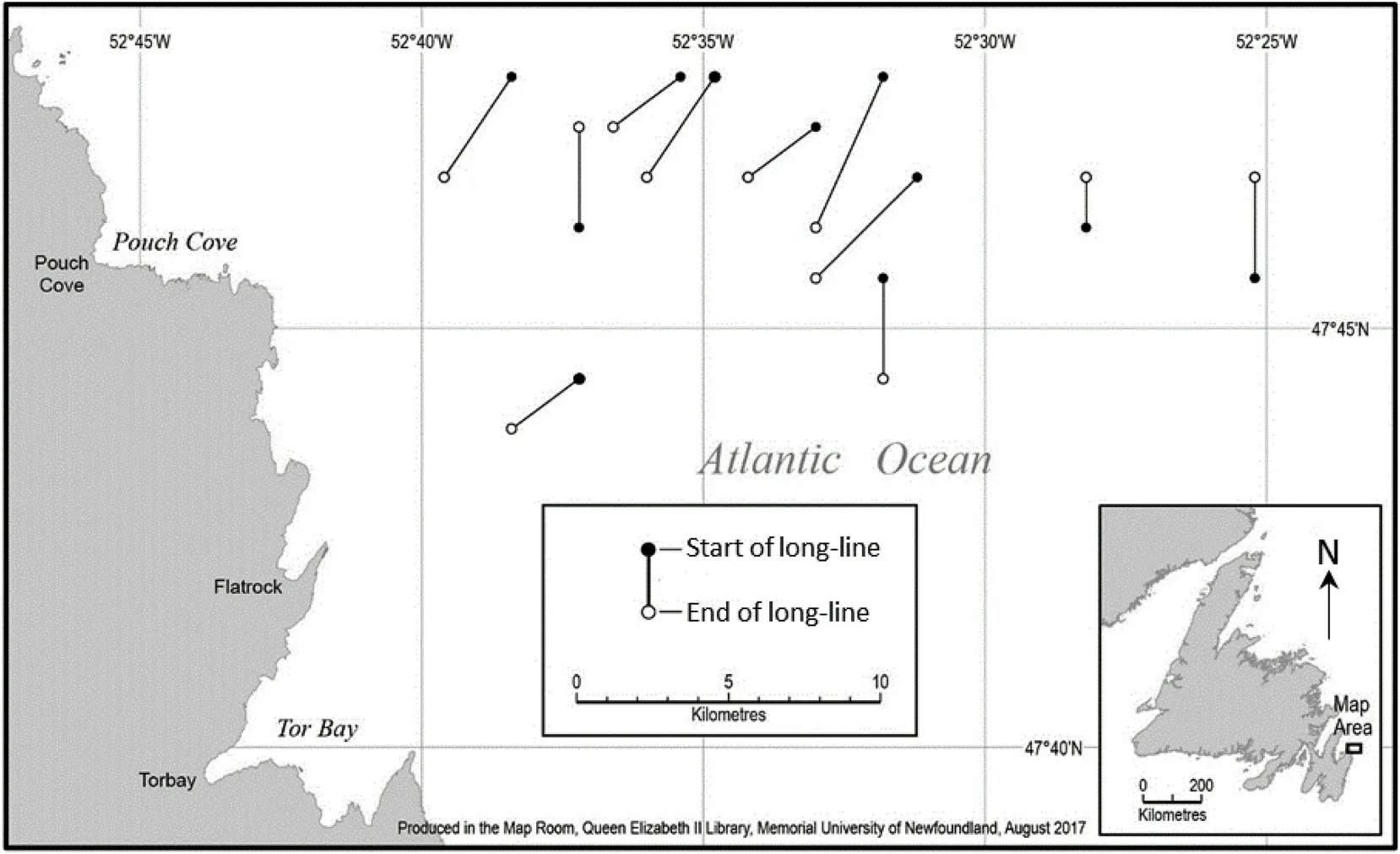
Fig. 1. Location of the study area, along the northeast coast of the island of Newfoundland, Canada. Lines and symbols indicate the placement and orientation of each long-line of traps.
In treatments where the light was in the upright orientation, the seabed is accentuated by the light emitted. By comparison, treatments where the light was in the upside down orientation tended to accentuate the plastic collar by the light emitted. Distance from the seabed to the light was 23 cm for the high location and 9 cm for the low location.All lights were hung in the entrance of the trap directly opposite the bait. All control and four experimental treatments were randomly placed throughout the long-line for comparative purposes. The order was selected by random draw. We assumed that the light emitted from a trap did not affect neighboring traps.
For each trap hauled, the number of legal-sized and sublegal-sized crabs were separated, counted and recorded as the catch per unit effort(CPUE). A random selection of crab were measured (carapace width,CW) to the nearest mm using Vernier calipers. Animals with CW <95 mm were recorded as sublegal-sized, and animals with CW ≥95 mm were recorded as legal-sized. Non-targeted animals (e.g.,female crab and other species) were also counted and measured for size.Only legal-sized male crabs were retained for commercial purposes and placed in the hold of the vessel. All other individuals were immediately returned alive over the side of the vessel into the sea.
2.2. Analysis
We built the model to estimate the effect of trap treatments on CPUE of crab using the generalized linear mixed-effect model (GLMM) based on the Poisson regression. Our catch data violated many of the assumptions needed for parametric approaches (e.g. ANOVA), which were count data and not normal distribution. In addition, the field experiment required that the traps were placed within a long-line for comparative purpose, and control and four experimental treatments were, therefore nested within a long-line, with multiple long-lines conducted during the sea trials. Since each trap within long-line shared a sampling site, traps on same long-line are not likely to be independent in a statistical sense. Techniques such as GLMM enable us to measure the effect of trap treatment on CPUE, while accounting for the nonnormal distribution and data with nested structure (Zuur, Ieno, Walker,Saveliev, & Smith, 2009). Evidence suggested that the data were overdispersed - noted by the dispersion parameter for quasipoisson family greater than 1 (3.26 for legal-sized and 3.13 for sublegal-sized crab) thus a negative binomial distribution was used. Residuals met the assumptions for homogeneity, normality, and independence. In our initial model, we tested the fixed effects of treatment and soak time containing three values of 4 days, 6 days, and 15 days (explanatory variables). Long-line number (ID) was included as a random effect on the CPUE (response variable). The model included an interaction term for treatment x soak time. In order to improve statistical power we then conducted stepwise model simplification, dropping non-significant terms one at a time until all terms in the model were statistically significant.
To fit the model we used theglmmadmbfunction based on package ofglmmADMBin RStudio. A preliminary analysis indicated that zeroinflation was not significant and therefore dropped. The catch data of legal and sublegal-sized crab were tested separately. The model structure was as follows:

Wilcoxon Rank-Sum Test was then used to compare the mean CPUE of legal and sublegal-sized crab among experimental treatments, including the effects of light location, light orientation, and soak time.
Comparison of the mean CW of crab caught by different treatments was conducted using ANOVA. Post-hoc comparisons were carried out using Tukey's SHD method. Size frequency distributions were compared using Kolmogorov-Smirnov two-sample Z test. GLMM was not used inthis analysis because visual inspection of data suggested that CW was not associated with ID, we therefore could not include the ID as a random effect. In addition, CW exhibited a normal distribution. Thus,parametric tests were used and all assumptions were met with regard to homogeneity of variance, normal distribution of errors, and independence of errors.
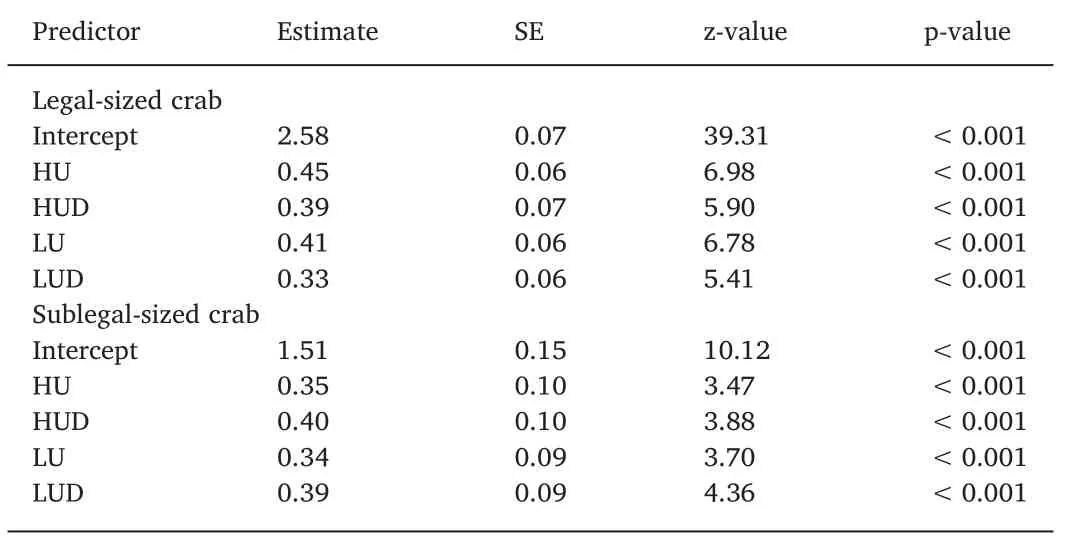
Table 1 Parameter estimates and fit statistics of the GLMM model, with negative binomial distribution of catches. HU is High Upright; HUD is High Upside Down;LU is Low Upright; and LUD is Low Upside Down.
3. Results
A total of 10 long-lines and 580 traps were successfully deployed and retrieved during the study, containing 364 control traps, 50 HU traps, 46 HUD traps, 60 LU traps, and 60 LUD traps. In some cases,apparent disturbance of a trap was observed upon haul-back (e.g., light malfunction, broken meshes, or upside down) and these traps were omitted from the analysis. We also omitted the first and last three traps in each long-line as our experience indicates these “end” traps tend to“dance” with the upward pull of the vertical down-ropes, lowering their fishing performance (Bungay, Winger, & Walsh, 2015).
Results from the GLMM revealed there was no significant interaction between trap treatment and soak time (p >0.05) for both legalsized and sublegal-sized crab. The interaction term was therefore dropped from the models. In the reduced model, we found that soak time was not statistically significant, and this term was also sequentially omitted from the model. The final model included only trap treatment,which was statistically significant (p <0.001) for both legal-sized and sublegal-sized crab (Table 1).
Illuminated traps captured a mean of 48% (95%CI: 1.37-1.59) more legal-sized crab than the control traps, including 57%, 51%, 48%, and 39% in the HU, LU, HUD, and LUD traps, respectively (Fig. 2, Table 1).Based on the model parameters, the predicted CPUE was 13.2, 20.7,19.9, 19.5, and 18.35, for control, HU, LU, HUD, and LUD treatments,respectively. Illuminated traps also captured a mean of 45% (95%CI:1.29-1.62) more sublegal-sized crab than the control traps, including 42%, 49%, 41%, and 48% in the HU, LU, HUD, and LUD traps, respectively (Fig. 2). Based on the model parameters, the predicted CPUE was 4.5, 6.4, 6.7, 6.3, and 6.7, for control, HU, LU, HUD, and LUD treatments, respectively. However, subsequent pairwise comparisons of CPUE indicated no significant differences among the four light treatments for both legal and sublegal-sized crabs (p >0.05) (Fig. 2).
Further examination revealed that there were no significant differences in CPUE of both legal and sublegal-sized crab between the high positions (i.e. high upright and high upside down combined) and low positions (i.e. low upright and low upside down combined)(W = 6086.5, p = 0.475 for legal sized crab; W = 5434.5, p = 0.475 for sublegal sized crab) (Fig. 3). Similar results were observed for the light orientations (upright, upside down). No significant differences in CPUE were detected between upright (including high upright and low upright combined) and upside down (including high upside down and low upside down combined) traps (W = 6643, p = 0.076 for legal-sized crab; W = 5700.5, p = 0.778 for sublegal sized crab) (Fig. 3).
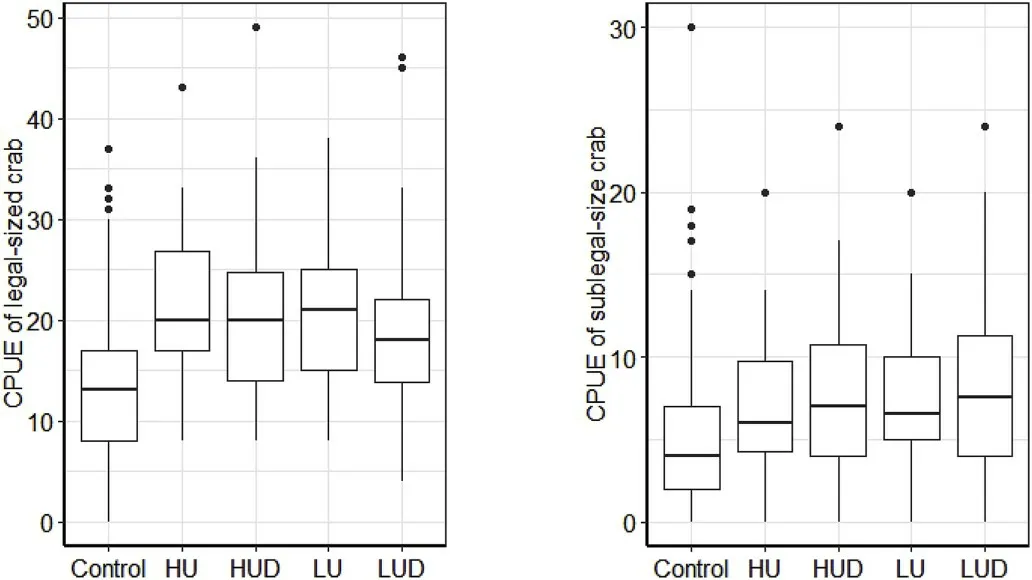
Fig. 2. Boxplots of CPUE of snow crab captured by control traps and four different experimental treatments. Left panel: legal-sized crab. Right panel: sublegal-sized crab. HU is high upright. HUD is high upside down. LU is low upright, and LUD is low upside down.
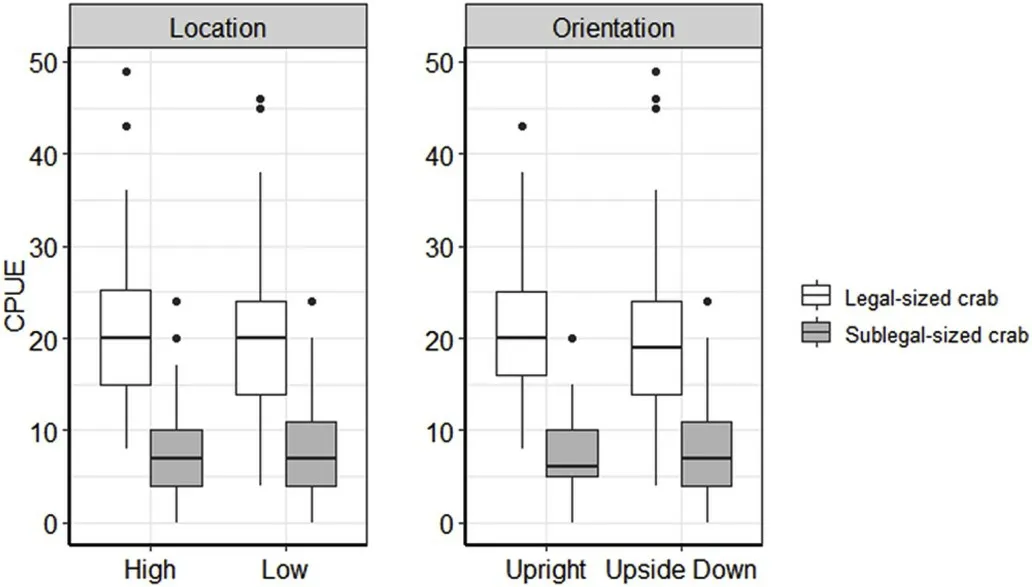
Fig. 3. Boxplots of CPUE of crab classified by legal and sublegal size for the different light locations (e.g., high combined and low combined; left panel) and orientations (e.g., upright combined and upside down combined; right panel).
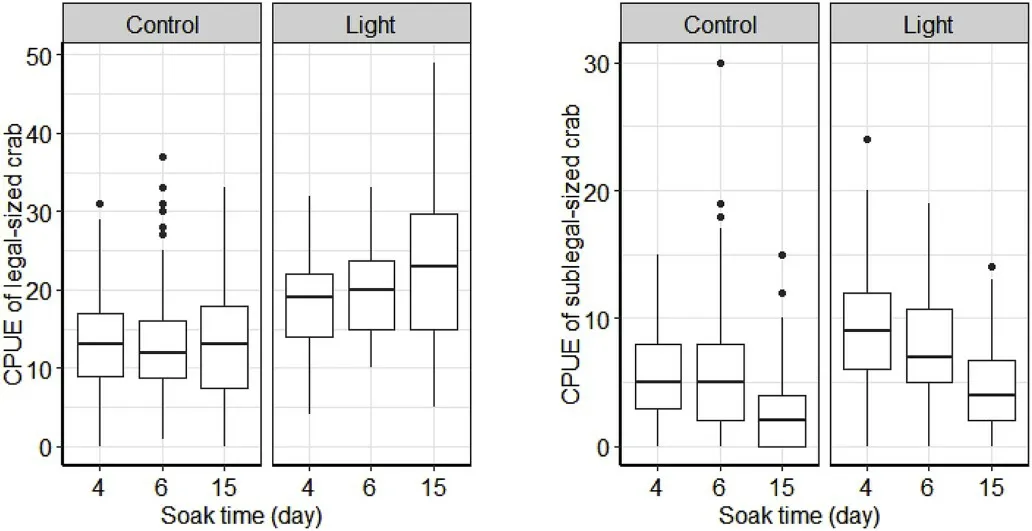
Fig. 4. Boxplots of CPUE of snow crab classified by different soak time. The left panel represents legal-sized crab and the right panel represents sublegal-sized crab caught. Figures denoted as Light include all 4 light treatments combined.
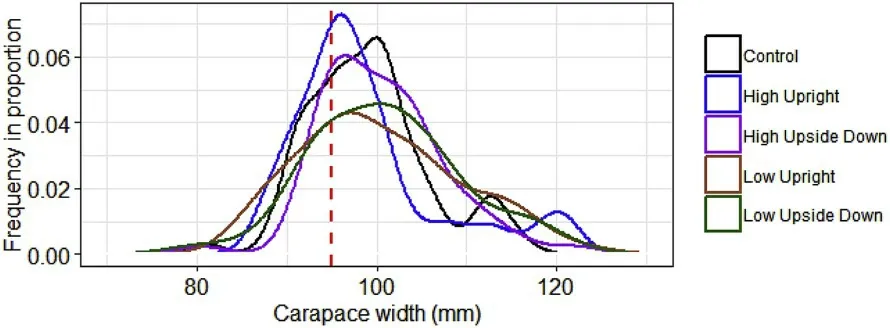
Fig. 5. Length distribution of snow crab recorded in the different experimental treatments. Red dashed line is minimum landing size (95 mm CW).
Soak time did not affect the CPUE of the control traps for legal-sized crab (Fig. 4). Pairwise comparisons showed no statistical difference between 4 and 6 days (W = 8483, p = 0.607), no statistical difference between 4 and 15 days (W = 7318.5, p = 0.688), and no statistical difference between 6 and 15 days (W = 5928, p = 0.5638) (Table 2). In contrast, longer soak times produced significantly higher CPUE in the illuminated traps for legal-sized crab (Fig. 4). Illuminated traps soaked for 15 days harvested the highest catch, producing a mean CPUE of 23.2 crab/trap, followed 20.1 crab/trap when soaked 6 days, and 18.4 crab/trap when soaked 4 days (Table 2). For sublegal-sized crab, the mean CPUE decreased with increasing soak time (Fig. 4). The number of sublegal crab decreased from 5.9 to 9.1 crab/trap when soaked 4 days,down to 2.8 and 4.8 crab/trap when soaked 15 days, for control and illuminated traps, respectively.
Legal sized crab dominated the catch in all experimental treatments.A total of 296 crabs were measured for CW during the experiment. The proportion of legal-sized and sublegal-sized crab accounted for 73%and 27%, respectively for both control and illuminated traps. Pairwise comparisons of crab size distribution indicated no significant differences between control traps and illuminated traps, as well as among illuminated traps using Kolmogorov-Smirnov test (p >0.05 for all pairwise comparisons), except high upright and low upside down comparison (Kolmogorov-Smirnov test, D = 0.3, p = 0.023) (Fig. 5).Mean CW ranged from 99.01 to 100.95 mm for the different treatments(Table 3). The illuminated traps had no significant effect on mean CW using ANOVA (F = 0.834, p = 0.504). Mean size of crab and pairwise comparisons are shown in Table 3.
4. Discussion
Compared to control traps (without light), the addition of LED lights inside the traps produced a significant increase in CPUE in this study.The catch rate of legal-sized crab increased on average 48% in traps equipped with white LED lights, with no significant difference among the different locations and orientations of the lights. These results suggest that ‘how’ the trap is illuminated is immaterial to snow crab.We speculate then, that whatever the light illuminates (e.g., the trap,the seafloor, or even conspecifics), is less important than the light itself.These findings lend support for the hypothesis that snow crab simplyfind white LED light to be a novel stimulus in a dark and barren landscape. In other words, simply the presence of the light, and not what the light illuminates, appears to be important.

Table 2 Mean CPUE of legal and sublegal size crab captured by the different soak times and their comparisons using Non-parametric Wilcoxon Rank-Sum Test. As mean ± standard error. (NS) indicates no significant difference. (S) indicates significant difference detected.

Table 3 Mean CW recorded for the different treatments and their pairwise post hoc comparison using Tukey's HSD. CW is carapace width. SE is standard error. CI is confidence interval. HU is High Upright; HUD is High Upside Down; LU is Low Upright; and LUD is Low Upside Down. (NS) indicates no significant difference.(S) indicates significant difference detected.
Our finding that artificial lights increase CPUE in stationary fishing gears is consistent with previous comparative fishing experiments. For example, the CPUE of large scale fish-traps, cod traps, and snow crab traps were shown to increase up to 200%, 80%, and 77%, respectively with the addition of underwater lights inside the fishing gear (Bryhn et al., 2014; Masuda, Kai, Kumazaw, & Matsushita, 2013; Nguyen et al.,2017). Recent research in Sweden has also shown that underwater lights can increase the catch rates of Northern shrimp (Pandalus borealis) in baited traps (Ljungberg & Bouwmeester, 2018). However performance is known to vary across different fishing gears and species.For example, lightsticks play a role in attracting target species (i.e.,swordfish, tuna) to pelagic longlines, but may affect the capture of sea turtles (Witzell, 1999). How much sea turtles are affected is unclear.Lohmann et al. (2006) and Wang, Boles, Higgins, and Lohmann (2007)found that turtles were attracted to light used by lightsticks, but Gless,Salmon, and Wyneken (2008) found the opposite conclusion and stated there were too many confounding factors to conclude that lightsticks attracted sea turtles to longlines. For gillnets and set-nets, the use of LED lights were found to help sea turtles avoid the fishing gear(Darquea, Medina, Alfaro-Sigueto, & Mangel, 2016; Ortiz et al., 2016;Virgili, Vasapollo, & Lucchetti, 2018; Wang, Fisler, & Swimmer, 2010).
Assuming an average 48% increase in CPUE is representative for commercial fishing enterprises in the province of Newfoundland and Labrador, the wide spread use of LED lights is predicted to substantially increase the profitability of the fishery. While a detailed economic analysis has not been completed, our rough calculations indicate that an investment of LED lights will produce high variable costs in the short term for a fishing enterprise, but over time it would recover the investment, at which point they would earn profit due to increased catch rates and reduced operating time (i.e., trips). Our review of the scientific literature in which the economic benefits of making such adjustments to fishing gears resulted in surprisingly few examples (e.g.,O’Neill, Lines, Kynoch, Fryer, & Maguire, 2014; SEAFISH, 2017). By comparison, several studies have investigated the benefits of abovewater use of LED lights in different fishing applications. An, He,Arimoto, and Jang (2017) showed that replacing traditional metal halide lights with LED lights on vessels targeting hairtail (Trichiurus lepturus) around the Korean Peninsula, increased their initial investment cost, but fishing enterprises would achieve a “break-even” point relatively quickly depending on the fuel price and number of fishing trips per year. Similar economic benefits have been documented for squid jigging fisheries in Japan (e.g., Matsushita, Azuno, & Yamashita, 2012),purse seine fisheries in Vietnam (e.g., Nguyen & Tran, 2015), and liftnet fisheries in Indonesia (e.g., Susanto, Irnawati, & Syabana, 2017).
Our results revealed several positive benefits of longer soak times when using LED lights in crab traps. Increasing the soak time from 4 to 6 days, and from 4 to 15 days, increased the catch of legal crab by 9.2%and 26.0% on average, respectively. These findings are consistent with Nguyen et al. (2017) who reported that snow crab traps with lights performed better as soak time increased. The authors speculated that bait plays a pivotal role in the first few days of soaking, but as the odour depletes, illuminated traps begin to perform better as they continue to attract crab irrespective of bait. The findings from this study support this hypothesis. We also found that increasing soak time significantly reduced the capture of sublegal crab. While increased soak times are known to generally promote sorting and improve trap selectivity(Olsen, Herrmann, Sistiaga, & Grimaldo, 2019; Winger & Walsh, 2011),the effect appears to be enhanced when traps are equipped with lights.Functional explanations for this finding are unclear, but it may be related to small crab finding and escaping through the exterior walls of the traps with greater efficiency due to enhanced visual capability (i.e.,small crab are able to see and feel their way through the meshes).
However, our results showed that traps equipped with LED lights also harvested a higher CPUE of sublegal-sized crab compared to control traps, yielding on average 45% higher CPUE of sublegal crab than control traps. This suggests that white LED lights increase the vulnerability of both legal and sublegal-sized crab to capture. While this suggests a potential conservation issue associated with the unnecessary handling of pre-recruit crab (Grant, 2003), this impact must be considered in the context of a) fishing enterprises are simultaneously catching their allocated quota of legal size snow crab faster, thus reducing the overall number of trips and trap hauls over the fishing season, and b) the survival of hard-shelled crab released over the side of the vessel is generally high when done properly (Dufour, Bernier, &Brêthes, 1997; Grant, 2003).
In conclusion, this study demonstrated that installing low-powered LED lights in snow crab traps produced an average increase in CPUE of legal-sized crab by 48% and that the location and orientation of the light does not appear to be important. For Canadian fishing enterprises,using LED lights to increase CPUE of snow crab traps permits the opportunity to catch individual quotas with greater efficiency. This means potentially fewer days on the water and the possibility of reduced operating costs (e.g., less bait, fuel, labour), thereby improving the financial viability of thousands of small owner-operated businesses.
Acknowledgements
Funding for this project was provided by the Fisheries and Marine Institute, Memorial University. We wish to acknowledge Bob Parsons for his in-kind contribution through the use of his vessel. We are also grateful to crew ofF/V Flat Rock Byesfor their valuable assistance setting-up the experimental equipment. We also thank our colleagues Tomas Araya-Schmidt for assisting with data collection and David Mercer for assisting with Fig. 1.
 Aquaculture and Fisheries2019年6期
Aquaculture and Fisheries2019年6期
- Aquaculture and Fisheries的其它文章
- A corpus-based approach to understanding market access in fisheries and aquaculture international business research: A systematic literature review
- Genes for sexual body size dimorphism in hybrid tilapia (Oreochromis sp. x Oreochromis mossambicus)
- Somatostatin 4 regulates growth and modulates gametogenesis in zebrafish
- Transcriptome analysis of gill from Lateolabrax maculatus and aqp3 gene expression
- Inter-individual variation in trophic history of Dosidicus gigas, as indicated by stable isotopes in eye lenses
